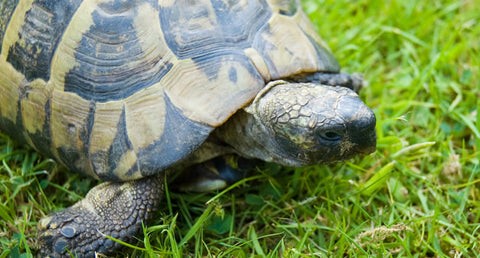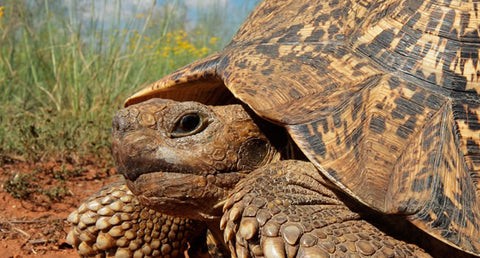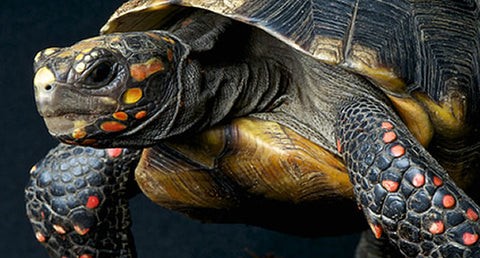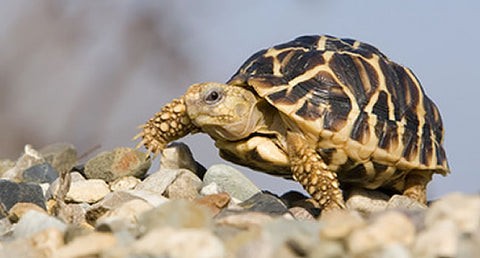Are you curious about how big a pet tortoise can get and looking for a lifelong reptile companion? At PETS.EDU.VN, we understand the importance of choosing the right tortoise species and providing the appropriate care, which includes understanding their potential size. This comprehensive guide will explore the varying sizes of popular pet tortoises, offering valuable insights into their care requirements and ensuring you can provide a happy, healthy life for your shelled friend with expert insights into tortoise sizes and care. We’ll cover everything from tortoise growth rates to habitat considerations and dietary needs, ensuring your tortoise thrives.
1. Understanding Tortoise Size Variations
Tortoises exhibit a remarkable range in size, varying significantly between species. Understanding these size differences is crucial for prospective owners to ensure they can provide an appropriate habitat and care throughout the tortoise’s life. Choosing a tortoise whose adult size aligns with your available space and resources is essential for responsible pet ownership.
1.1 Small Tortoise Species
Several tortoise species remain relatively small, making them suitable for keepers with limited space. These smaller tortoises typically require less extensive enclosures and may have lower overall care costs.
- Mediterranean Spur-Thighed Tortoise ( Testudo graeca ): As mentioned previously, this tortoise typically reaches around 8 inches (20 cm) in length.
- Hermann’s Tortoise (Testudo hermanni): Similar in size to the Spur-Thighed Tortoise, Hermann’s Tortoises usually grow to be 7-9 inches (18-23 cm) long.
- Indian Star Tortoise (Geochelone elegans): Known for its beautiful star-shaped markings, this tortoise typically reaches 8-12 inches (20-30 cm) in length.
1.2 Medium-Sized Tortoise Species
Medium-sized tortoises strike a balance, offering a manageable size for many keepers while still providing the rewarding experience of caring for a larger reptile. These species require more space than smaller tortoises but are not as demanding as their giant counterparts.
- Leopard Tortoise (Stigmochelys pardalis): These tortoises can grow considerably larger, reaching lengths of 13-18 inches (33-46 cm).
- Red-Footed Tortoise (Chelonoidis carbonaria): Native to South America, these colorful tortoises typically grow to 12-16 inches (30-41 cm) in length.
1.3 Large Tortoise Species
Large tortoise species demand a significant commitment due to their substantial size and specialized care requirements. Potential keepers must be prepared to provide ample space, robust enclosures, and a diet that can sustain their growth.
- African Spur-Thighed Tortoise (Geochelone sulcata): Also known as the Sulcata Tortoise, this is one of the largest mainland tortoises, reaching lengths of 24-36 inches (60-90 cm).
Table 1: Common Tortoise Species and Their Adult Sizes
| Species | Adult Size (Inches) | Adult Size (Centimeters) |
|---|---|---|
| Mediterranean Spur-Thighed | 8 | 20 |
| Hermann’s Tortoise | 7-9 | 18-23 |
| Indian Star Tortoise | 8-12 | 20-30 |
| Leopard Tortoise | 13-18 | 33-46 |
| Red-Footed Tortoise | 12-16 | 30-41 |
| African Spur-Thighed (Sulcata) | 24-36 | 60-90 |




2. Factors Influencing Tortoise Size
A tortoise’s size is influenced by a complex interplay of genetic and environmental factors. Understanding these factors is crucial for providing optimal care and promoting healthy growth.
2.1 Genetics
Genetics play a primary role in determining the potential size of a tortoise. Each species has a genetically predetermined size range, which sets the upper and lower limits of their growth. For example, an Indian Star Tortoise will never reach the size of an African Spur-Thighed Tortoise, regardless of environmental conditions.
2.2 Diet and Nutrition
Proper nutrition is essential for healthy growth and development. A balanced diet, rich in essential nutrients, vitamins, and minerals, supports optimal growth rates. Conversely, malnutrition or an improper diet can lead to stunted growth or health problems. According to the Journal of Animal Physiology and Animal Nutrition, a diet lacking in calcium and vitamin D3 can severely impact shell development and overall growth in tortoises.
2.3 Habitat and Environment
The size and quality of the habitat significantly influence a tortoise’s growth. A spacious enclosure allows for adequate exercise and exploration, promoting muscle development and overall health. Additionally, proper temperature gradients, humidity levels, and access to UVB and UVA lighting are crucial for healthy growth and shell development.
2.4 Overall Health
A tortoise’s overall health status can significantly impact its growth. Illnesses, parasites, and infections can hinder growth rates and lead to long-term health problems. Regular veterinary check-ups and prompt treatment of any health issues are essential for ensuring healthy growth.
3. Understanding Growth Rates
Tortoise growth rates vary significantly between species and individual animals. Monitoring growth rates is an important aspect of tortoise care, helping to identify potential health issues or environmental deficiencies.
3.1 Hatchling Growth
Hatchling tortoises typically exhibit rapid growth during their first few years of life. During this period, they require a nutrient-rich diet and optimal environmental conditions to support their development. Regular weighing and measuring can help track their growth and identify any potential problems early on.
3.2 Juvenile Growth
As tortoises enter their juvenile stage, their growth rate typically slows down. However, they still require a balanced diet and appropriate environmental conditions to ensure continued healthy development. Monitoring their growth and adjusting their care as needed is essential during this stage.
3.3 Adult Growth
Once tortoises reach adulthood, their growth rate slows down significantly or ceases altogether. While they may continue to gain weight, their overall size typically remains stable. Maintaining a healthy diet and providing appropriate exercise is crucial for preventing obesity and other health problems in adult tortoises.
4. Enclosure Size Requirements
Providing an appropriately sized enclosure is essential for the health and well-being of your tortoise. The enclosure should be large enough to allow for adequate exercise, exploration, and thermoregulation.
4.1 Minimum Enclosure Sizes
The minimum enclosure size for a tortoise depends on its species and adult size. As a general rule, the enclosure should be at least four times the length and twice the width of the adult tortoise. However, larger enclosures are always preferable, as they provide more space for exercise and exploration.
4.2 Indoor vs. Outdoor Enclosures
Whether to house your tortoise indoors or outdoors depends on your climate and the specific needs of your tortoise species. Outdoor enclosures provide natural sunlight and fresh air, which are beneficial for overall health. However, they may not be suitable for all climates or tortoise species. Indoor enclosures offer more controlled environmental conditions but require artificial lighting and heating to meet the tortoise’s needs.
4.3 Enclosure Design
The design of the enclosure should also consider the tortoise’s natural behaviors and needs. Providing hiding places, basking spots, and a variety of substrates can enrich the environment and promote psychological well-being. Additionally, the enclosure should be secure enough to prevent escapes and protect the tortoise from predators.
5. Nutritional Needs for Growth
A well-balanced diet is crucial for a tortoise’s healthy growth and overall well-being. Their diet should consist primarily of leafy greens, vegetables, and fruits, with occasional supplementation as needed.
5.1 Dietary Components
- Leafy Greens: These should make up the bulk of the diet, providing essential vitamins, minerals, and fiber. Good options include dandelion greens, collard greens, and romaine lettuce.
- Vegetables: Offer a variety of colorful vegetables to provide a range of nutrients. Carrots, squash, and bell peppers are good choices.
- Fruits: Fruits should be offered in moderation due to their high sugar content. Berries, melons, and apples can be given as occasional treats.
5.2 Supplementation
Depending on the tortoise species and its diet, supplementation may be necessary to ensure it receives all the essential nutrients. Calcium and vitamin D3 supplements are particularly important for promoting healthy shell development. Consult with a veterinarian or reptile specialist to determine the appropriate supplementation for your tortoise.
5.3 Feeding Frequency
Hatchling and juvenile tortoises typically require daily feeding to support their rapid growth. Adult tortoises can be fed every other day or a few times a week, depending on their species and activity level.
6. Common Health Issues Related to Size and Growth
Several health issues can arise if a tortoise’s size and growth are not properly managed. Being aware of these potential problems is crucial for providing appropriate care and seeking timely veterinary attention.
6.1 Metabolic Bone Disease (MBD)
Metabolic Bone Disease is a common health problem in captive tortoises, often caused by a deficiency in calcium, vitamin D3, or both. Symptoms include soft or deformed shell, lethargy, and muscle weakness. MBD can be prevented by providing a balanced diet, UVB lighting, and appropriate calcium and vitamin D3 supplementation.
6.2 Shell Pyramiding
Shell pyramiding is a condition in which the scutes (the individual segments of the shell) develop an uneven, pyramid-like shape. While the exact cause of shell pyramiding is not fully understood, it is often associated with improper humidity levels, overfeeding, and a diet high in protein. Maintaining appropriate humidity levels, providing a balanced diet, and avoiding overfeeding can help prevent shell pyramiding.
6.3 Obesity
Obesity is a common problem in captive tortoises, particularly those that are kept in small enclosures and fed a high-calorie diet. Overweight tortoises are at increased risk of developing health problems such as liver disease, heart disease, and joint problems. Providing a spacious enclosure, a balanced diet, and encouraging regular exercise can help prevent obesity.
7. Choosing the Right Tortoise for Your Lifestyle
Selecting the right tortoise species for your lifestyle is a crucial decision that requires careful consideration. Factors such as available space, time commitment, and financial resources should all be taken into account.
7.1 Assessing Your Lifestyle
Before acquiring a tortoise, it’s essential to honestly assess your lifestyle and determine if you can provide the necessary care. Consider the following:
- Available Space: Do you have enough space for an appropriately sized enclosure, both indoors and outdoors?
- Time Commitment: Are you willing to dedicate the time necessary for daily feeding, cleaning, and monitoring your tortoise’s health?
- Financial Resources: Can you afford the costs associated with purchasing an enclosure, lighting, heating, substrate, food, and veterinary care?
7.2 Researching Different Species
Once you’ve assessed your lifestyle, research different tortoise species to find one that aligns with your capabilities. Consider the following factors:
- Adult Size: What is the adult size of the species, and can you provide an appropriately sized enclosure?
- Dietary Needs: What are the dietary requirements of the species, and can you provide a balanced and varied diet?
- Environmental Needs: What are the temperature, humidity, and lighting requirements of the species, and can you provide a suitable environment?
7.3 Responsible Acquisition
Acquire your tortoise from a reputable breeder or rescue organization. Avoid purchasing tortoises from pet stores or online vendors that may not provide proper care or accurate information. Responsible breeders and rescue organizations prioritize the health and well-being of their animals and can provide valuable guidance on tortoise care.
8. Legal and Ethical Considerations
Before acquiring a tortoise, it’s essential to be aware of any legal and ethical considerations that may apply in your area.
8.1 Local Laws and Regulations
Some tortoise species may be protected by local laws and regulations, requiring permits or licenses for possession. Research your local laws and regulations before acquiring a tortoise to ensure you are in compliance.
8.2 Conservation Status
Many tortoise species are threatened or endangered in the wild due to habitat loss, poaching, and other factors. Supporting responsible breeding programs and avoiding the purchase of wild-caught tortoises can help protect these vulnerable species.
8.3 Ethical Considerations
Keeping a tortoise as a pet is a long-term commitment that requires careful consideration of the animal’s welfare. Providing appropriate care, a spacious enclosure, and a stimulating environment is essential for ensuring the tortoise’s physical and psychological well-being.
9. Preparing for Your Tortoise
Before bringing your tortoise home, it’s essential to prepare its enclosure and gather all the necessary supplies.
9.1 Setting Up the Enclosure
Set up the enclosure well in advance of bringing your tortoise home to ensure that the temperature, humidity, and lighting are stable. Provide a basking spot with a temperature of 95-100°F (35-38°C) and a cooler area with a temperature of 75-80°F (24-27°C). Maintain appropriate humidity levels for the species.
9.2 Gathering Supplies
Gather all the necessary supplies before bringing your tortoise home, including:
- Enclosure
- Substrate
- Basking lamp
- UVB lamp
- Thermometer
- Hygrometer
- Food and water dishes
- Hiding places
- Food
9.3 Quarantine
Quarantine your new tortoise for at least 30 days before introducing it to any other reptiles. This will help prevent the spread of disease and allow you to monitor your new tortoise’s health closely.
10. Bringing Your Tortoise Home
Bringing your tortoise home is an exciting experience, but it’s essential to handle the transition carefully to minimize stress.
10.1 Acclimation
Allow your new tortoise to acclimate to its new environment gradually. Place it in the enclosure and allow it to explore at its own pace. Avoid handling it excessively during the first few days.
10.2 Feeding and Hydration
Offer your new tortoise fresh food and water daily. Monitor its appetite and ensure it is eating and drinking regularly.
10.3 Observation
Observe your new tortoise closely for any signs of illness or stress. If you notice anything unusual, consult with a veterinarian or reptile specialist.
11. Long-Term Care and Maintenance
Providing long-term care and maintenance is essential for ensuring your tortoise lives a long and healthy life.
11.1 Regular Veterinary Check-ups
Schedule regular veterinary check-ups for your tortoise to monitor its health and identify any potential problems early on.
11.2 Enclosure Cleaning
Clean the enclosure regularly to remove waste and prevent the buildup of harmful bacteria.
11.3 Diet Monitoring
Monitor your tortoise’s diet and adjust it as needed to ensure it is receiving all the essential nutrients.
11.4 Environmental Control
Maintain appropriate temperature, humidity, and lighting levels in the enclosure to ensure your tortoise’s comfort and well-being.
12. Finding Reliable Information and Support
Caring for a tortoise can be a rewarding experience, but it’s essential to have access to reliable information and support.
12.1 Veterinarians
Find a veterinarian with experience in reptile care to provide medical attention for your tortoise.
12.2 Reptile Experts
Consult with reptile experts or breeders for guidance on tortoise care and husbandry.
12.3 Online Resources
Utilize online resources such as forums, websites, and social media groups to connect with other tortoise keepers and learn from their experiences.
Remember, responsible pet ownership means providing the best possible care for your tortoise throughout its life. With the right knowledge, resources, and dedication, you can ensure your shelled friend thrives for many years to come.
At PETS.EDU.VN, we strive to provide accurate and up-to-date information on all aspects of pet care. Our team of experts is dedicated to helping you provide the best possible life for your animal companions.
13. The Joy of Tortoise Keeping
While this guide has covered many important aspects of tortoise care, it’s also important to remember the joy and fulfillment that comes with keeping these fascinating creatures.
13.1 The Unique Personality of Tortoises
Each tortoise has its own unique personality and quirks. Observing their behaviors and learning their individual preferences can be a deeply rewarding experience.
13.2 The Long Lifespan of Tortoises
Tortoises are known for their long lifespans, with some species living for over 100 years. This means that acquiring a tortoise is a long-term commitment, but also an opportunity to form a lasting bond with a truly remarkable animal.
13.3 The Educational Value of Tortoise Keeping
Keeping a tortoise can be an educational experience for both children and adults. Learning about their biology, behavior, and conservation status can foster a greater appreciation for the natural world.
By providing appropriate care, a stimulating environment, and plenty of love and attention, you can ensure your tortoise thrives and brings you joy for many years to come.
14. Advanced Tortoise Care
For experienced tortoise keepers, there are always new challenges and opportunities for learning. Exploring advanced topics such as breeding, specialized diets, and complex medical conditions can further enhance your understanding and appreciation of these fascinating creatures.
14.1 Breeding Tortoises
Breeding tortoises can be a rewarding experience, but it requires a significant commitment of time, resources, and expertise. Understanding the specific breeding requirements of each species is essential for success.
14.2 Specialized Diets
Some tortoises may require specialized diets to address specific health conditions or nutritional deficiencies. Consult with a veterinarian or reptile specialist to determine the appropriate diet for your tortoise.
14.3 Complex Medical Conditions
Tortoises can be susceptible to a variety of complex medical conditions, requiring advanced diagnostic and treatment techniques. Finding a veterinarian with expertise in reptile medicine is essential for providing the best possible care.
15. Conclusion: Ensuring a Happy and Healthy Life for Your Tortoise
Caring for a tortoise is a long-term commitment that requires careful planning, diligent care, and a deep understanding of their unique needs. By providing an appropriately sized enclosure, a balanced diet, and a stimulating environment, you can ensure your tortoise lives a happy and healthy life for many years to come.
Remember to research different tortoise species to find one that aligns with your lifestyle and capabilities. Acquire your tortoise from a reputable breeder or rescue organization. Be aware of any legal and ethical considerations that may apply in your area. Prepare your enclosure and gather all the necessary supplies before bringing your tortoise home. And most importantly, provide your tortoise with plenty of love, attention, and care.
At PETS.EDU.VN, we are committed to providing accurate and up-to-date information on all aspects of pet care. We encourage you to explore our website for more articles, resources, and advice on caring for your tortoise.
FAQ: Frequently Asked Questions About Tortoise Size
1. How big do Sulcata tortoises get?
Sulcata tortoises are one of the largest tortoise species in the world. They can grow up to 24-36 inches (60-90 cm) in length and weigh up to 200 pounds (90 kg).
2. How fast do tortoises grow?
Tortoise growth rates vary depending on the species, diet, and environmental conditions. Hatchlings typically grow quickly during their first few years of life, while adult tortoises grow much more slowly or not at all.
3. What is the smallest tortoise species?
The smallest tortoise species is the Speckled Padloper (Homopus signatus), which typically reaches only 3-4 inches (7-10 cm) in length.
4. How long do tortoises live?
Tortoise lifespans vary depending on the species, with some species living for over 100 years.
5. How much space do tortoises need?
The amount of space a tortoise needs depends on its species and adult size. As a general rule, the enclosure should be at least four times the length and twice the width of the adult tortoise.
6. What do tortoises eat?
Tortoises are primarily herbivores, and their diet should consist mostly of leafy greens, vegetables, and fruits.
7. Do tortoises need UVB lighting?
Yes, tortoises need UVB lighting to synthesize vitamin D3, which is essential for calcium absorption and healthy shell development.
8. How often should I bathe my tortoise?
The frequency of bathing depends on the species and its environmental conditions. Most tortoises benefit from regular soakings to stay hydrated and maintain healthy skin and shell.
9. How can I tell if my tortoise is healthy?
Signs of a healthy tortoise include a smooth, hard shell, bright eyes, a good appetite, and regular bowel movements.
10. Where can I get a tortoise?
Tortoises can be acquired from reputable breeders, rescue organizations, or pet stores.
Unlock Expert Tortoise Care at PETS.EDU.VN
Navigating the world of tortoise care can be challenging, but you don’t have to do it alone. At PETS.EDU.VN, we provide a wealth of information and resources to help you provide the best possible care for your shelled companion.
Are you struggling to find reliable information about tortoise nutrition, health, or habitat requirements? Do you worry about providing the right environment for your tortoise to thrive?
PETS.EDU.VN offers in-depth articles, expert advice, and personalized support to address all your tortoise care concerns. Whether you’re a first-time tortoise owner or an experienced keeper, our website is your go-to source for all things tortoise.
Visit PETS.EDU.VN today to:
- Browse our extensive library of articles on tortoise care
- Connect with our team of reptile experts for personalized advice
- Find trusted local services, including veterinarians and reptile specialists
Don’t let the challenges of tortoise care overwhelm you. Let PETS.EDU.VN be your guide to ensuring a happy, healthy, and fulfilling life for your shelled friend.
Contact us:
- Address: 789 Paw Lane, Petville, CA 91234, United States
- WhatsApp: +1 555-987-6543
- Website: PETS.EDU.VN
Take the first step towards becoming a confident and knowledgeable tortoise owner. Visit pets.edu.vn now and unlock the secrets to successful tortoise keeping.
Remember, a well-informed owner is a tortoise’s best friend.
